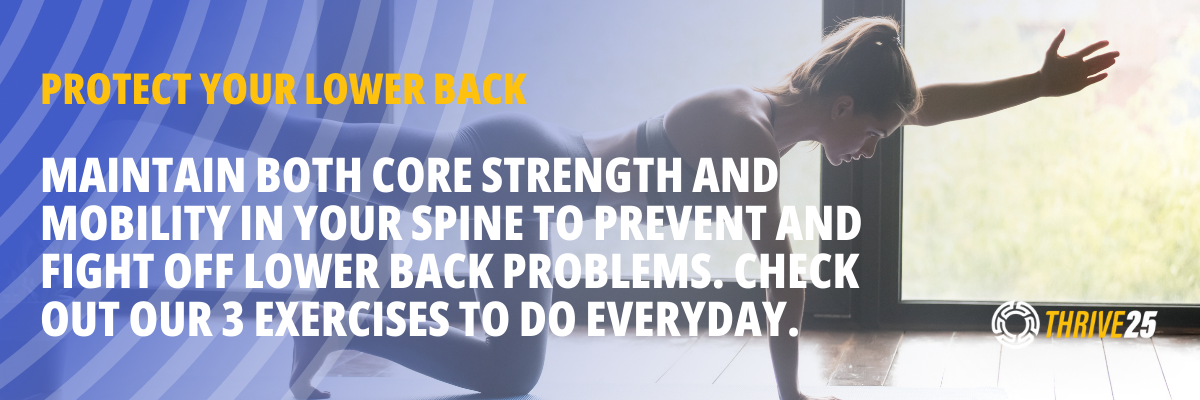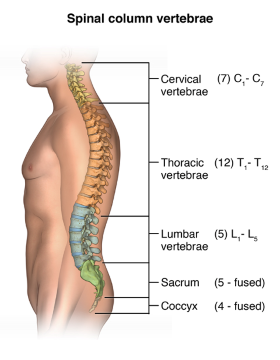Issue #345: The 3 Exercises To Protect Your Lower Back
Good morning. It’s Tuesday, May 21st.
Stat of the Day
The number of muscles in our body - we need 100 just to stand up. No wonder there’s a good chance one of them aches if we don’t take care of them.
Learn
Protect Your Lower Back
Ever complained about your lower back? It’s the most common liability in the world - 90% of us have experienced it and nearly two-thirds of people over 50 have missed a week or more of work due to back pain.
While it might seem like our back is super susceptible to injury - don’t blame nature.
Just consider what other design (biological or engineered) could come close to what our back does for us -
It provides crazy flexility - moving in 6 different directions
And unprecedented support - sustaining up to 3,300 lbs
We put our back through a lot - and that’s when we’re doing things the right way. Think about what happens when we’re not treating our spine with the love and respect it deserves.
Lower Back Injuries
Most back injuries happen in our lower back - between the L4-L5 vertebrae of our lumbar spine.
The reason for this is that our upper spine around our neck is thinner and designed to optimize flexibility. We’re turning our heads all day long and need this to be more mobile.
Our lower back is optimized for stability. It’s thicker so it’s more rigid.
That’s normally ok - but because we’ve decided to spend all of our time sitting, slouching, and not taking care of our core muscles we go past the point of what our lower back was supposed to do.
There are two keys for how to optimize our muscles to support our lower back:
Get stronger
Stay in equilibrium
The first one isn’t surprising. Lacking core muscles like our abs or glutes increases reliance on our back, leading to strain on the muscles in our lower back. This potentially messes up our vertebrae with a slipped or herniated disc or worse.
But what do we mean by equilibrium? Life is all about balance and we want to make sure that our body is in alignment - that goes for both our muscles and our spine.
Who is most likely to see an orthopedic surgeon for a back surgery?
First - it’s those who don’t exercise. No surprise.
But it’s also powerlifters and yogis.
That’s because if all you do is hit the weights - even with the right form - you put constant pressure on your spine and don’t give it the flexibility it needs to stay nimble and free of injury.
Similarly, if you can touch your forehead to your knees but never build up your strength - you don’t give your spine the support it needs to manage all the compression it endures.
PRO TIP: It’s not just muscle we build when we increase our strength. Our bones get bigger too. The bones in Rafael Nadal’s left arm (the one he uses to hit a tennis ball thousands of times a day) are up to 30% bigger than his right arm.
The key is the middle of the road - doing a few days of strength training to build strong muscles (and bones) and a few days of mobility training to maintain flexibility - with a ton of walking everyday.
The other part of balance is making sure each side of our body is equivalently strong and flexible. That’s true whether it’s side to side (left vs. right side of our lower back) or front and back. Don’t build up huge quads without working out your butt and hamstrings (my problem).
Try
Top 3 Core Exercises
From Dr. Stuart McGill - here are the Top 3 exercises to do everyday to build that core strength and equilibrium to prevent lower back injuries:
1. McGill Curl-Up - it’s not really a curl-up (or sit-up). Lay on your back with one leg out straight in front of you and the other with knee bent and foot flat on the floor. Put your hands under your low back to support the curve of your spine and raise your neck (chin down towards your chest) for 5-10 seconds - focusing on flexing your abs without losing the arch of your spine.
2. Side Plank - it’s like it sounds - a plank but on the side (on one elbow and foot). The key is to really focus on form with strong obliques so that your shoulder doesn’t come forward and your hip doesn’t dip towards the floor. Again you can hold for 10 seconds and then eventually work up to roll from one side to the other. (Note: like the plank, there’s tons of variations here)
3. Bird Dog - this exercise supports back extension and glutes. Starting from table top position raise up one leg behind you trying to touch the back wall with your heal and, at the same time, raise your opposite arm in front of you - reaching as far as you can. Hold for 10 seconds on each side.
Here’s a video with all the details on the best form:
Try doing a Descending Pyramid - 3 sets of each exercise, then 2 sets, then 1 set. 1-2 Pyramids a day will go a long way to supporting your lower back.
PRO TIP: Make sure you are breathing through each exercise during the 10 second hold.
Thrive25 Partner Spotlight
Want more valuable nutrients?
Magnesium is a master mineral - we covered the benefits of Magnesium in Issue #21. The only form that gets into the brain is Magnesium Threonate (MgT).
The Momentous Magnesium Threonate supplement is clinically proven to improve cognitive function and enhance the quality of sleep (huge when you have a back injury). So it’s become part of my personal supplement routine.
Thrive25 subscribers get 15% off the entire product portfolio using code Thrive at checkout. Click HERE!
Laugh
Graduation Day
The name’s Thomas…
In the News
Running Shoes: So many options from high-tech racers to cushioned trainers, it can be difficult to find what you need 🤷♀️. Check out this list to connect your goals to your new shoe. (Outside)
Synthetic DNA: The White House introduced new regulations to control synthetic DNA - to keep manufacturers from creating pandemic-causing pathogens. Smart move. (WIRED)
Control Your Immune Response: A new discovery in the vagus nerve may have significant implications for treating diseases by dialing up or down inflammation. Goodbye diabetes, arthritis, and autoimmune disorders? Not yet, but in the realm of possibility. (Big Think)
Thanks for joining us today!
Check out the latest videos on our YouTube channel
Got feedback, recommendations or stories to share? Tell us what’s on your mind here
Want this direct to your inbox? Sign up here
Why Thrive25
We’re 40-something dads that felt our bodies and minds start to slow down and we’re not ready for that. We found too much information on every subject. So we started Thrive25 to transform what we’ve learned into something useful for the rest of us to spend just 3-5 min a day to optimize our health & longevity.
This newsletter is for you and we truly value your feedback. Never hesitate to reach out to us at team@thrive25.com.
To health!
Sign up for free:
The information in this newsletter is for informational purposes only and may not be appropriate or applicable based on your individual circumstances. Thrive25, Inc. does not provide medical, professional, or licensed advice. Please connect with your healthcare professional for medical advice specific to your health needs.








